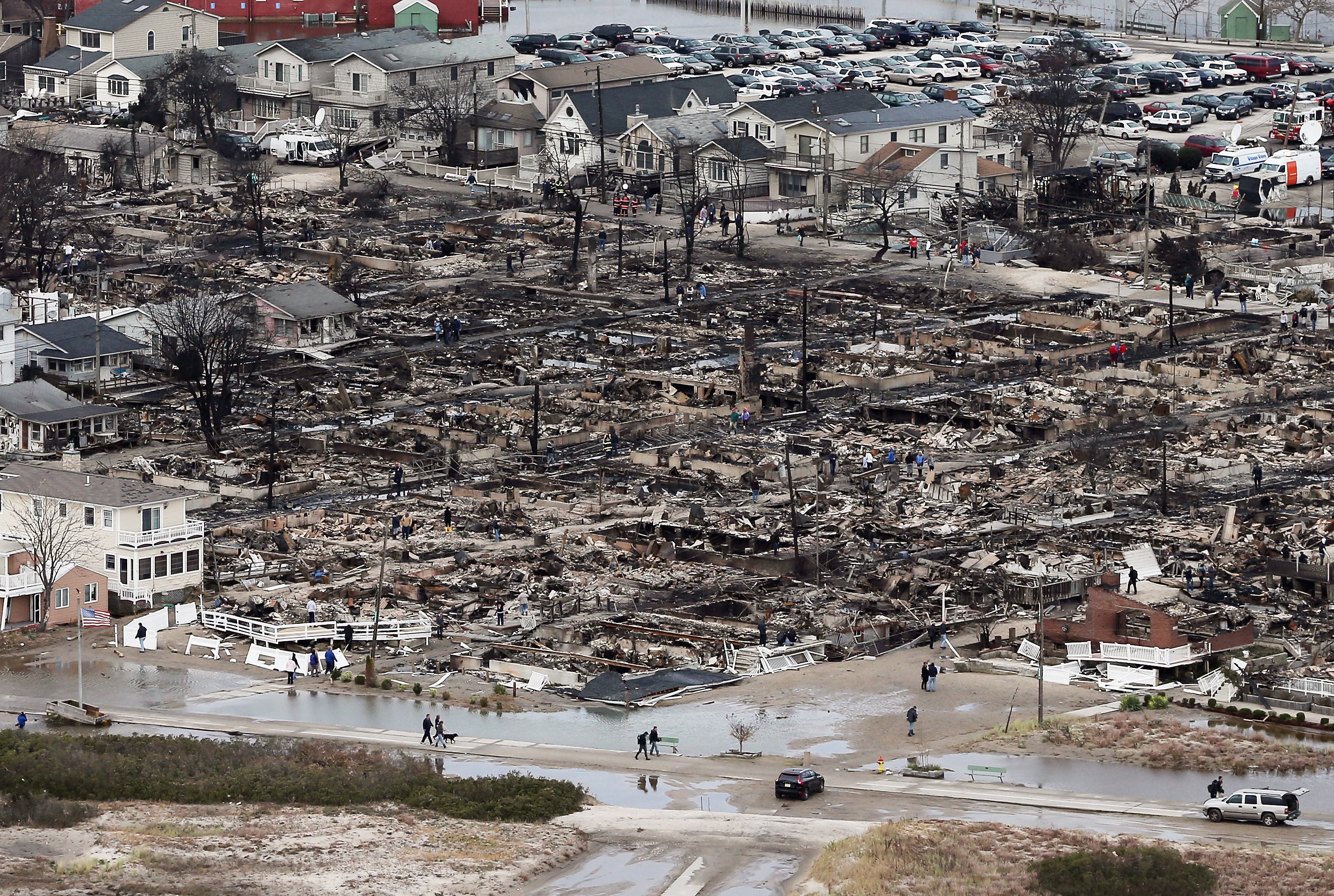Hurricane Sandy, 10 years on: A look back at The Independent’s reporting from America’s ‘shock and awe’ storm
Sandy killed 233 people and caused billions of dollars in damage when it struck the Northeast in October 2012

On 29 October 2012 Superstorm Sandy struck New York, bringing the city to its knees. Some 44 people were killed in the city, with a total of 233 perishing in the devastating storm which impacted the entire Eastern Seaboard and the Caribbean. Record coastal flooding and ferocious winds led to widespread destruction – and recovery continues to this day.
The Independent covered the immediate aftermath in New York City and met residents who decided not to flee when Sandy bore in. The article below was originally published on Wednesday, 31 October 2012 along with a front page on America’s “shock and awe storm”.
Ahmed Sisoko was driving home to the Bronx from lower Manhattan shortly after Superstorm Sandy came ashore in southern New Jersey on Monday night. “It was crazy,” said Mr Sisoko, a taxi driver who has been plying his trade on New York’s streets for more than a decade. “Crazy, crazy, crazy! Very bad. Wind, rain, trees falling. Couldn’t see anything. I’ve never seen anything close.”
As Mr Sisoko ploughed through the rain, Mary Moonie was watching an episode of Prime Suspect at her apartment in Battery Park City along the Hudson River, where the storm surge exceeded 13 feet. Ms Moonie was among those who defied official warnings to evacuate from low-lying areas. “We evacuated for [Hurricane] Irene,” she said. “This time we decided to stay. But it was scary, particularly the wind.”
Further north, Christa Schaub was camped inside her West Village apartment. “It was like [the Will Smith movie] I Am Legend around here, just me, my dog and a couple of candles,” she said. Her apartment overlooks Washington Square; concerned about loose branches as the wind howled, she had reinforced her windows. “The scary thing was being cut off,” she said. “My power went out at 8:30pm, and I have no [mobile phone] signal.”
Ms Schaub wasn’t alone. About a quarter of New York’s homes and business were without power the morning after Sandy slammed the city with pounding rain and record tidal surges. Making matters worse was a massive explosion at a lower Manhattan substation just as utility companies were shutting parts of the grid to protect equipment on Monday night.
Among those spared by the power cuts was Herbie Ledger, who lives on Rector Street in the Battery Park area. Although inside the evacuation zone like Ms Moonie, he was one of the few who got through the night with little disruption.
TJ Westfall, who lives nearby, had a similar experience. “We moved out last year. But then, nothing really happened down here – and there was power,” he said. This time, he admits, “we got lucky”.

“It was quite bad – but the excess water got flushed down the Brooklyn Battery tunnel,” he said.
The flooded tunnel remained closed yesterday. The rising waters have left the men and women running New York’s vast Subway system – the country’s biggest – with a major headache. The Subway was closed before the storm hit, but scores of underground stations were flooded. At one downtown stop, the water was “literally up to the ceiling”, said Joseph Lhota, the chairman of New York’s Metropolitan Transit Authority.
Taxis, unsurprisingly, were hard to come by yesterday. Powerless and in many cases without phone service or the ability to venture too far afield, many Manhattanites had little to do but survey the damage – mostly fallen tree branches and damaged scaffolding – in their neighbourhoods. Other districts did not escape so lightly; in Queens, dozens of homes were burnt down in an inferno fuelled by the storm’s fierce winds.
Around Washington Square, University Avenue and Union Square most shop fronts were still dark at mid-morning, and the few coffee-shops that had opened their doors in the worst-affected areas were overflowing with customers.
Further north, near Central Park, a police line was still holding gawkers from venturing too close to the site of the crane that was damaged by furious winds on Monday.

Amoz Diaz, a security guard on duty two blocks away when the crane at the construction site snapped and was left dangling dozens of stories above ground, said he received a phone call alerting him at around 4pm. “We got a call and then they blocked off the area – all of that,” he said, pointing in the direction of the cordon. “It was pretty quick. They closed it off very fast.”
Just as quickly, a small crowd had formed at the cordon after daybreak on Tuesday, as the damaged crane continued to dangle from its perch. Some had come especially, while others appeared to be just passing by when they noticed the partly-built tower that was all over the evening news. “It’s quite amazing what happened,” taxi driver Mr Sisoko said as he changed fares nearby.
Join our commenting forum
Join thought-provoking conversations, follow other Independent readers and see their replies
Comments
Bookmark popover
Removed from bookmarks